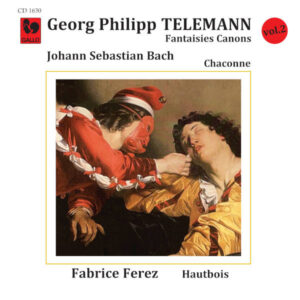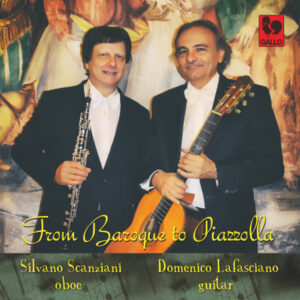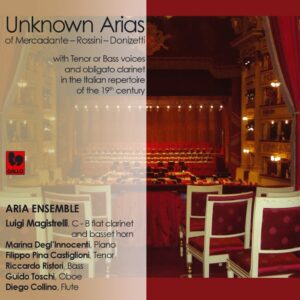Extraits / Excerpts
Telemann : Fantasia & Canonic Sonata "Canon Mélodieux" – Fabrice Ferez, Oboe Solo, Vol. 1 (With Playback Bonus Tracks)
Georg Philipp TELEMANN : Fantasia No. 11 in G Major, TWV 40:12 – Canonic Sonata No. 6 in A Minor, TWV 40:123 – Fantasia No. 6 in D Minor, TWV 40:7 – Fantasia No. 1 in A Major, TWV 40:2 – Fantasia No. 2 in A Minor, TWV 40:3 – Canonic Sonata No. 1 in G Major, TWV 40:118 – Fantasia No. 8 in E Minor, TWV 40:9 – Johann Sebastian BACH : Partita No. 2 in D Minor, BWV 1004: I. Allemande – IV. Gigue – Georg Philipp TELEMANN : Fantasia No. 4 in B-Flat Major, TWV 40:5 – Wilhelm Friedemann BACH : Flute Duet No. 2 in E-Flat Major, F. 55: I. Allegro – Georg Philipp TELEMANN : Canonic Sonata No. 6 in A Minor, TWV 40:123 (Playback) – Canonic Sonata No. 1 in G Major, TWV 40:118 (Playback).
Fabrice Ferez, Oboe Solo.
Kostenlose Musikpartitur der Canonic Sonata
Telemann, the power of imagination
The cycle of the Twelve fantasias for flute solo, though surrounded by hundreds of oratorios, dozens of passions or operas, holds a singular place in Telemann’s huge work. First of all, it is one of the few rare opuses were engraving and publication was carried out by Telemann himself, in Hamburg, in 1732.
It is also remarkable as the first series of fantasias composed for a wind instrument. This genre, so closely linked to improvisation, was by its very nature intended for keyboard instruments, which were the natural choice of the creators of the time. Diderot’s Encyclopédie actually defines a fantasia as ‘An instrumental work composed as it is performed.’
These Twelve fantasias are a true demonstration of Telemann’s capacity for invention and thus contradict the vision that would make him a composer who was certainly precocious, gifted and prolific but above all routine
and conventional. They vividly sketch out, sometimes in a few notes, musical worlds that take us from the most melancholy to the most joyful exaltation with an astonishing sense of contrast and humour.
One could compare them to the works of the great painters, who sometimes say more in their sketches than in their finished artworks.
Vanitas, Vanitatum
François La Riche (1662-1733), the great French oboist whose playing brought glory to the Dresden orchestra and whom Telemann heard in Berlin in Bononcini’s opera Polyphema, may have dreamed of playing these fantasias. They were originally written for the transverse flute, an instrument brought to the fore by La Riche’s fellow musicians Michel Blavet (1700-1768) and Johann Joachim Quantz (1697-1773). Telemann who gave so much to the oboe would certainly have been seduced by this idea. This instrument was so familiar to him, as the king of French music in his hundreds of orchestral ouvertures.
Over the past few decades and particularly from the moment Heinz Holliger (born in 1939) became well-known, contemporary oboists have adopted the Twelve fantasias for themselves as an interesting repertoire for
solo instrument of the Baroque period and a suitable counterpart for the repertoire of the twentieth century. Performing them also provides the chance for solitary reflection, an opportunity to encounter oneself. In the opening minor key pages of the second, sixth or eight fantasias this encounter reminds him, like the still lives of the 17th century painters of vanity that ‘thus passes the glory of the world.’
FABRICE FEREZ
Fabrice Ferez is principal oboe in the Victor Hugo Franche Comté Orchestra, Oboe Teacher at the Greater Besançon Conservatoire and Artistic co-Director of the Tetraktys Ensemble. An insatiable chamber music player, arranger, and occasional conductor and composer, he likes to live and to share music of all kinds.
- Kategorien
- Komponisten
- Interpreten
- Booklet














